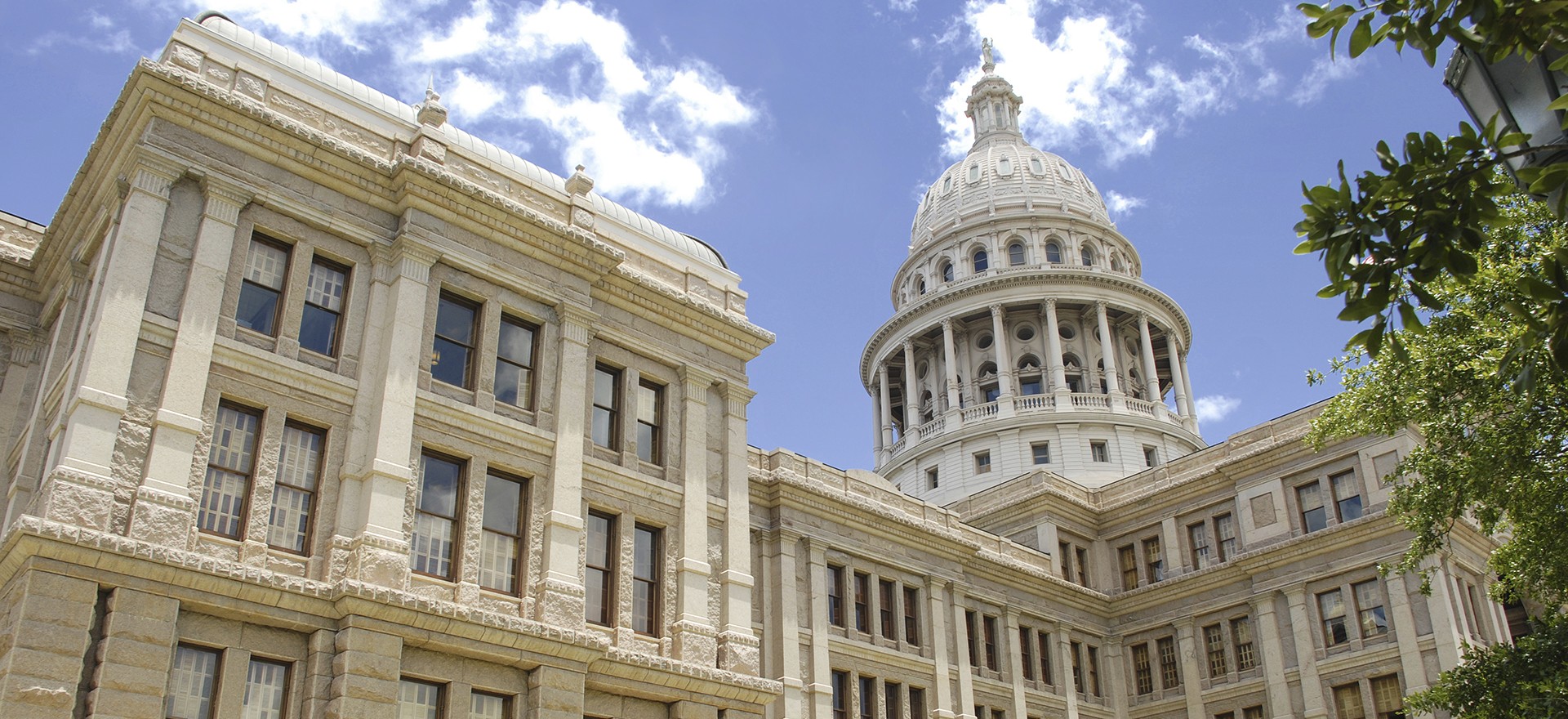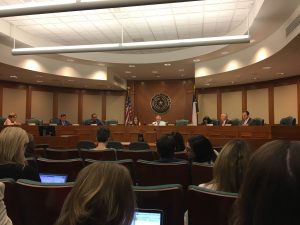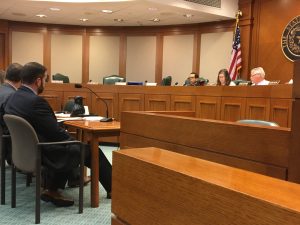ATPE testifies at Texas Capitol regarding teacher pay

Texas Legislature
Date Posted: 8/08/2018 | Author: Mark Wiggins
The House Public Education Committee met Wednesday at the Texas Capitol to discuss interim charges relating to teacher compensation and charter schools. Chairman Dan Huberty (R-Houston) began by noting that this meeting concludes the committee's interim charges, and he does not plan on calling another committee meeting this year.
Texas Education Agency (TEA) Commissioner Mike Morath kicked off the day’s invited testimony with an update on the state’s “A through F” accountability system. The agency is expected to release the first round of ratings for districts on August 15, while campuses will still be rated under the “met standard/improvement required” system until next year. Morath explained a number of adjustments to the system that were made as a result of stakeholder feedback.
Asked by Rep. Huberty how the ratings compare to last year when measured under the current system, Morath said the state lost a total of 260 improvement required (IR) campuses, representing a historic year-over-year improvement. Asked about the impact of the TEA waiver for IR campuses affected by Hurricane Harvey, the commissioner explained that 1,200 campuses were eligible for relief under the Harvey protocols. Of those, “something like 86” campuses that were on track to receive an IR designation instead received a “not rated” designation under the waiver.
Rep. Gary VanDeaver (R-New Boston) expressed concern over the system’s dependence on high-stakes testing, and cautioned members of the committee against using tests in ways for which they are not intended. Morath indicated his belief that summative assessments such as the STAAR are perfectly suited for evaluating campus-level effectiveness.
Morath then shifted to the following interim charge designated by Speaker Joe Straus (R-San Antonio):
Review current state mechanisms for identifying and rewarding educators through state-level strategies. Examine how providing additional funding to enhance compensation in districts facing a shortage of experienced, highly rated teachers would affect retention and teacher quality, in addition to whether it would encourage teachers to provide additional services through extracurricular activities, tutoring, and mentoring.
The commissioner began by laying out the new teacher appraisal system, T-TESS, as well as currently available training and curricular resources. Morath said teachers are the TEA’s first strategic priority, but said compensation is only part of the puzzle. The commissioner highlighted research showing that only 23% of new U.S. teachers came from the top third of their graduating class. Pay is the top reason college graduates choose not to become teachers, and average pay has fallen compared to other professions. Compensation similarly does not grow at the same rate as other professions. Morath praised the performance pay program in Dallas ISD, but Rep. Huberty steered the commissioner toward focusing on how to pay for such programs.
The commissioner indicated that in order to implement strategic staffing programs like the Dallas ISD ACE program that incentivizes high-performing teachers to teach at the most at-risk campuses, the state could provide additional formula funding through the Foundation School Program (FSP) tied to levels of economically disadvantaged students. Rep. Alma Allen (D-Houston) suggested the state should raise the base pay, including the minimum salary schedule. Morath indicated part of the challenge of instituting a performance-based pay system is identifying top teachers, but noted that many school systems have done so successfully. The commissioner also indicated that any funding to raise teacher pay should provide administrators a guarantee that funding will continue.
Chairman Huberty asked Morath direcly what it would cost to implement Dallas ISD’s performance pay program across the state of Texas. According to Morath, the program would carry a startup cost of around $50 million and an annual cost of roughly $1 billion over a ten-year period. This would provide average raises between $4,000-5,000, with top teachers able to earn up to six-figure salaries.
Vice-chair Diego Bernal (D-San Antonio) repeatedly questioned invited witnesses who cautioned against basing teacher evaluations on their students’ high-stakes test scores to provide an alternative metric to accurately identify top teachers. Representatives from educator organizations noted that standardized tests have not been validated for use evaluating the performance of individual teachers and pointed out there are a variety of alternatives.
ATPE Lobbyist Monty Exter testified that the positive results from the Dallas ISD ACE system are not necessarily correlated with the district’s teacher evaluation system, which is called the Teacher Excellence Initiative (TEI). Exter clarified that designating top teachers to utilize under the ACE model could be done equally effectively by utilizing T-TESS or another alternative evaluation system. Chairman Huberty expressed frustration, and indicated any program involving additional money from the state should provide the state with policy input. Asked by Chairman Huberty to offer specific recommendations, Exter suggested that lawmakers must take a systemic approach to directing the best teachers to the campuses facing the highest challenges. Such an approach would begin with the teacher pipeline and include wraparound supports as well as the possibility of differentiated pay.
The committee next considered the following interim charge regarding charters:
Review the charter school system in Texas. Determine if changes are needed in the granting, renewal, or revocation of charter schools, including the timeline for expansions and notification of expansions to surrounding districts. Review the educational outcomes of students in charter schools compared to those in traditional schools, and to what extent schools participate in the alternative accountability system. Monitor the implementation of facilities funding for charter schools. Consider differences in state funding for charter schools compared to their surrounding districts and the impact on the state budget. Consider admissions policies for charters, including appropriate data collection to assess demand for additional charter enrollment, compliance with access by students with disabilities and the effect of exclusions of students with criminal or disciplinary histories. Consider differences in charter and district contributions to the Teacher Retirement System on behalf of their employees and make appropriate recommendations to support the retirement benefits of all public school teachers.
TEA staff opened testimony with an overview of charter school statistics and the metrics for evaluating new charter applications. Chairman Huberty noted that the number of charter school campuses has increased while the number of charter holders has held steady around the statutory cap. Members had several questions regarding the statistics, including how student discipline is handled, the higher percentage of IR campuses than traditional school districts, and types of services offered.
Chief School Finance Officer Leo Lopez provided information regarding TRS contributions, facilities funding, and the implementation of district partnership contracts through Senate Bill (SB) 1882. Lopez noted that charters are not required to pay teachers the minimum salary schedule. Chairman Huberty pointed out that TRS contributions are not indexed to anything other than the minimum salary schedule, which has been long outdated as a current reflection of teacher salaries. As a result, contributions have not automatically increased along with inflation.
This year, charters will be eligible for facilities funding equaling on average just over $200 per student. This funding is capped at $60 million dollars annually. Regarding the amount of funding charters receive compared to traditional school districts, Lopez contended charters receive both more and less. Lopez noted at the outset that student profiles are different for each. While charters have higher levels of economically disadvantaged students, they have fewer special education students. It is also important to note that there are significant differences even among economically disadvantaged students, and traditional districts continue to serve the most students in extreme poverty.
CONVERSATION
RECOMMENDED FOR YOU

12/19/2025
Teach the Vote’s Week in Review: Dec. 19, 2025
Happy Holidays from ATPE! The ACLU of Texas is challenging SB 12 in federal court, and ATPE has distributed candidate surveys to those running for statewide, legislative, and SBOE seats.

12/18/2025
Gov. Abbott’s property tax promise and the split in the Texas GOP
Property taxes aren’t just a political talking point. They’re the main revenue source for vital local services, including police, fire, and public education.

12/12/2025
Dec. 8 filing deadline sets the stage for 2026 elections
Now’s the time to confirm your voter registration and update it if necessary.



